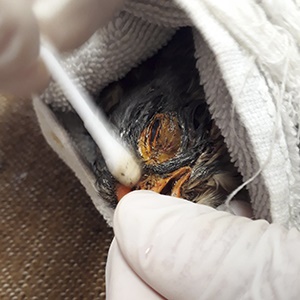this article from "The Star" 8 november.
She has made this transcontinental crossing before, but this time the fear is that she will fall victim to a catastrophe that threatens to destroy her species.
To a small group of bird enthusiasts she is known simply as 95778, an Amur falcon that has a small matchbox-sized satellite transmitter strapped to her back.
For nearly three years this GPS transmitter has given science a glimpse into the 14 500km migratory route this pigeon-sized bird of prey makes between South Africa and Mongolia.
95778 is on a return trip to South Africa, but she has stopped over at a killing field.
Thousands of Amur falcons heading to southern Africa are being killed on a daily basis in north eastern India. The birds are being captured in fishing nets and then sold as meat.
Supplied
Her last recorded position has her in the remote north-east Indian state of Nagaland.
Late last month a team of Indian conservationists travelled to the Doyang reservoir in Nagaland and what they found shocked them.
Tens of thousands of Amur falcons are being caught and sold for bush meat.
The numbers, they believe, are large enough to affect the survival of the species.
“What was shocking was not the sight of dead birds, but the scale of hunting,” says Ramki Sreenivasan of Conservation India.
The hunters, Sreenivasan says, set fishing nets high in the trees.
The birds are caught as they head to roost in the evenings. He estimates that at the height of the migration about 15 000 birds are killed daily.
“The peak of the migration lasts for about 10 to 15 days,” Sreenivasan explains. It could mean that a quarter of a million birds are slaughtered over this two-week period. Once the birds are caught, he says, hunters break the birds’ wings and keep them alive in pens made from mosquito netting.
The birds are sold for the equivalent of between R2.40 and R3.75 at markets.
“The birds that arrive here are probably tired,” says Sreenivasan. “They get stuck and hang until the hunter arrives early in the morning to disentangle them.”
Dr Craig Symes, an ornithologist at Wits University, believes that such mass killings are likely to have a detrimental effect on Amur falcon populations in South Africa. No one knows what the global population of this bird species is, but a count of Amur falcon roosts in South Africa in 2009 gave a figure of 111 000 birds.
Back in 2009, German birdwatcher Professor Dr Bernd-Ulrich Meyburg and his wife, Christina, travelled to Newcastle, KwaZulu-Natal, and with the help of members of BirdLife Northern Natal caught and attached satellite transmitters to 10 Amur falcons. Now, three years later, only 95778’s transmitter continues to plot her journey.
Thousands of Amur falcons heading to southern Africa are being killed on a daily basis in north eastern India. The birds are being captured in fishing nets and then sold as meat.
Supplied
Rina Pretorius of BirdLife Northern Natal says Meyburg told her on Monday night that the bird had been at the Nagaland site for the past two days.
“She told me that the bird is at that exact same spot [where they are killing them] and that she expected her to move off in the next two days.”
If 95778 makes it, she could be back in South Africa by next month.
“All we can do is hold thumbs,” Pretorius says.
The killing of Amurs is illegal in Nagaland, says Sreenivasan.
He says India is a signatory to the Convention on Migratory Species which is bound to provide safe passage to any migrating animal.
Thousands of Amur falcons heading to southern Africa are being killed on a daily basis in north eastern India. The birds are being captured in fishing nets and then sold as meat.
Supplied
Conservation India has informed authorities of the hunting, and the chief wildlife warden of Nagaland has issued instructions to seize netting and warn offenders that they can be arrested.
“This will be the last year that this happens,” Sreenivasan says.
“It is fixable, by hook, crook or carriage stick.”





